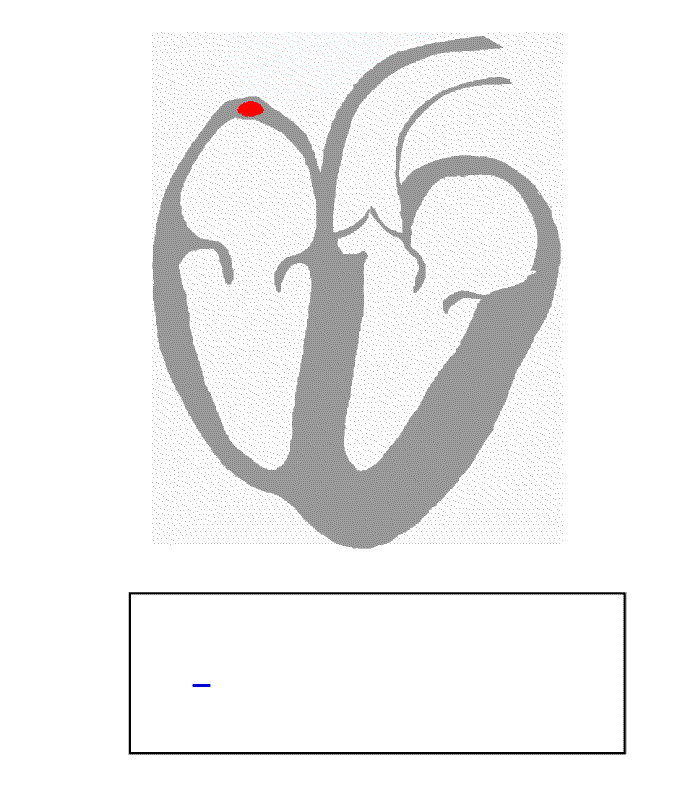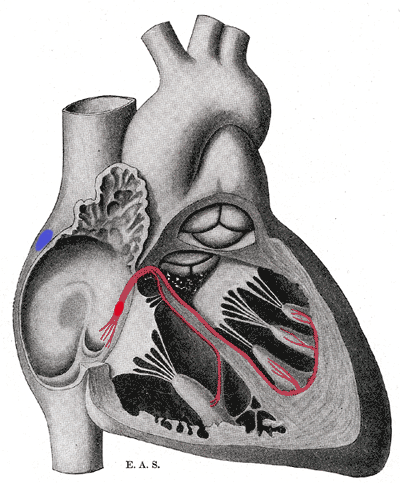Cardiac pacemaker


|
WikiDoc Resources for Cardiac pacemaker |
|
Articles |
|---|
|
Most recent articles on Cardiac pacemaker Most cited articles on Cardiac pacemaker |
|
Media |
|
Powerpoint slides on Cardiac pacemaker |
|
Evidence Based Medicine |
|
Cochrane Collaboration on Cardiac pacemaker |
|
Clinical Trials |
|
Ongoing Trials on Cardiac pacemaker at Clinical Trials.gov Trial results on Cardiac pacemaker Clinical Trials on Cardiac pacemaker at Google
|
|
Guidelines / Policies / Govt |
|
US National Guidelines Clearinghouse on Cardiac pacemaker NICE Guidance on Cardiac pacemaker
|
|
Books |
|
News |
|
Commentary |
|
Definitions |
|
Patient Resources / Community |
|
Patient resources on Cardiac pacemaker Discussion groups on Cardiac pacemaker Patient Handouts on Cardiac pacemaker Directions to Hospitals Treating Cardiac pacemaker Risk calculators and risk factors for Cardiac pacemaker
|
|
Healthcare Provider Resources |
|
Causes & Risk Factors for Cardiac pacemaker |
|
Continuing Medical Education (CME) |
|
International |
|
|
|
Business |
|
Experimental / Informatics |
Editor-In-Chief: C. Michael Gibson, M.S., M.D. [1]
The contractions of the heart are controlled by chemical impulses, which fire at a rate which controls the beat of the heart.
The cells that create these rhythmical impulses are called pacemaker cells, and they directly control the heart rate. Artificial devices also called pacemakers can be used after damage to the body's intrinsic conduction system to produce these impulses synthetically.
Control via the SA Node
Although all of the heart's cells possess the ability to generate these electrical impulses (or action potentials), a specialised portion of the heart, called the sinoatrial node, is responsible for the whole heart's beat.
The sinoatrial node (SA node) is a group of cells positioned on the wall of the right atrium, near the entrance of the superior vena cava. These cells are modified cardiac myocytes. They possess some contractile filaments, though they only contract relatively weakly.
Cells in the SA node will spontaneously depolarize, resulting in contraction, approximately 100 times per minute. This native rate is constantly modified by the activity of sympathetic and parasympathetic nerve fibers, so that the average resting cardiac rate in adult humans is about 60 beats per minute. Because the sinoatrial node is responsible for the rest of the heart's electrical activity, it is sometimes called the primary pacemaker.
If the SA node doesn't function, or the impulse generated in the SA node is blocked before it travels down the electrical conduction system, a group of cells further down the heart will become the heart's pacemaker, this is known as an ectopic pacemaker. These cells form the atrioventricular node (AV node), which is an area between the atria and ventricles, within the atrial septum.
The cells of the AV node normally discharge at about 40-60 beats per minute, and are called the secondary pacemaker.
Further down the electrical conducting system of the heart, the Bundle of His, the left and right branches of this bundle, and the Purkinje fibres, will also produce a spontaneous action potential if they aren't inhibited by other electrical activity. These tertiary pacemakers fire at a rate between 30-40 per minute.
Even individual cardiac muscle cells will contract rhythmically on their own.
The reason the SA node controls the whole heart is that its action potentials are released most often; this triggers other cells to generate their own action potentials. In the muscle cells, this will produce contraction. The action potential generated by the SA node, passes down the cardiac conduction system, and arrives before the other cells have had a chance to generate their own spontaneous action potential. This is the normal conduction of electrical activity within the heart.
Generation of Action Potentials
There are three main stages in the generation of an action potential in a pacemaker cell. Since the stages are analogous to contraction of cardiac muscle cells, they have the same naming system. This can lead to some confusion. There is no phase one or two, just phases zero, three and four.
Phase 4 - Pacemaker Potential
The key to the rhythmical firing of pacemaker cells is that, unlike muscle and neurons, these cells will slowly depolarize by themselves.
As in all other cells, the resting potential of a pacemaker cell (-60mV to -70mV) is caused by a continuous outflow or "leak" of potassium ions through ion channel proteins in the membrane that surrounds the cells. The difference is that this potassium permeability decreases as time goes on, partly causing the slow depolarization. As well as this, there is a slow inward flow of sodium, called the funny current, as well as an inward flow of calcium. This all serves to make the cell more positive.
This relatively slow depolarization continues until the threshold potential is reached. Threshold is between -40mV and -50mV. When threshold is reached, the cells enter phase 0.
Phase 0 - Upstroke
Though much faster than the depolarisation caused by the funny current and decrease in potassium permeability above, the upstroke in a pacemaker cell is relatively slow compared to that in an axon.
The SA and AV node do not have fast sodium channels like neurons, and the depolarisation is mainly caused by a slow influx of calcium ions. (The funny current also increases). The calcium is let into the cell by voltage-sensitive calcium channels that open when the threshold is reached.
Phase 3 - Repolarization
The calcium channels are rapidly inactivated, soon after they open. Sodium permeability is also decreased.
Potassium permeability is increased, and the efflux of potassium (loss of positive ions) slowly repolarises the cell.
Control of Heart Rate
| System | Sympathetic | Parasympathetic |
| innervation | from the cardiac nerves from the sympathetic chain | from the vagus nerve |
| chronotropic effects (heart rate) |
increased | decreased |
| dromotropic effects (AP conduction velocity) |
increased at AV node | decreased at AV node |
| inotropic effects (force of contraction) | increased (atria and ventricles) | decreased (only atria) |
| response | It takes a while for the heart rate to increase after noradrenaline is released. | Unlike the sympathetic mechanism, the heart will slow quite soon after vagal stimulation. |
| receptors | When the SA node receives sympathetic stimulation, noradrenaline (norepinephrine) released from the nerve endings binds to β1-adrenergic receptors on the pacemaker cell membrane. | Acetylcholine (ACh) is released from the vagus nerve endings, and binds to muscarinic receptors on the pacemaker cells. |
| mechanism | This binding causes cyclic AMP production within the cell. This directly increases the funny current, meaning sodium is continually entering the cell more quickly. Cyclic AMP also activates a protein kinase, that phosphorylates the calcium channels, increasing calcium conductance into the cell. Because both sodium, and calcium can enter the cell more quickly, the continuously natural depolarisation (phase 4) reaches threshold more quickly. So action potentials are generated more frequently. | In the pacemaker cells, there are ACh sensitive potassium channels. These open in response to ACh binding, potassium ions leak out, and the cell gets hyperpolarised (more negative). The funny current is also reduced by ACh. This means sodium ions enter more slowly, and it takes longer for the cell to reach threshold. In addition, calcium influx is reduced; therefore, when threshold is reached depolarization takes longer. Thus the heart rate slows. |
Hormonal effects can also affect the heart. Noradrenaline and adrenaline (also called Norepinephrine and Epinephrine respectively) are both released into the bloodstream by the adrenal medulla. They have the same action on heart rate as direct sympathetic stimulation.